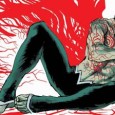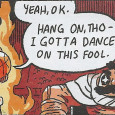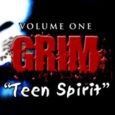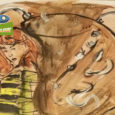In Charlyne Yi’s (actress, musician and, for brevity’s sake, all around creative) new adult-illustrated story collection, the writer and artist promises to take readers into her tortured mind of daydreamed parables. If this was her aim, then we suggest that Yi delivered. Oh, the Moon unfortunately reads just like it was inspired by barroom prophets and the vampire-hours kept by newly-minted and caffeine-stimulated young adults.
Be honest, is there anything more trepidatious than a friend’s insistence that you just have to listen to the wild dream that he or she had last night? Has the subsequent retelling ever really interested you or did you feign even passingly engaged attention? Is a half-remembered tale of your friend walking down the aisle in a dress made of pigeons that then turned into a pack of howling monkeys before the groom revealed himself to be Bart Simpson a model of good story-telling? It’s possible that I’m just a bad friend. If so, perhaps the sudden non-sequiturs that compose the narratives of Oh, The Moon’s longer stories are perfectly constructed out of transitional and-then-this-happeneds.
However, I’m just going to go ahead and insists that while a twist can be fantastical (especially in fantasy) it still should function as part of a larger story. Even a wrench, like those that form the epically silly journey to the grocer in Neil Gaiman’s Fortunately, The Milk, is framed and grounded in motivation and has a logical beginning and end. In Oh, the Moon, a man sells his soul to the devil for a tall hat, travels to the get it back at the behest of his lady-love, is for some reason led inside of a giant frog, and then dies soulless after getting struck by droplets of bile in the frog’s stomach. Only from the similarities in the artwork is it even clear that from page to page you are reading the same story.This isn’t the case for every entry in the collection, it is but certainly categorical of most of them
The art, however, does deserve some further mentioning. It’s delightful and plentiful. Yi has some real talent and each story is told with a unique style that shows that she has a range that deserves to be comparison to works like Tim Burton’s superb illustrated poetry collection The Melancholy Death of Oyster Boy & Other Stories. The art proves that Yi has a future in this strange but wonderful medium of adult-oriented illustration, even if her individual tales fall short of engaging story-telling.
Oh, the Moon by Charlyne Yi releases November 3rd from HarperCollins and is available for pre-order from Amazon, and local book retailers.
Kaitlyn D’Agostino
Content Editor
@deadrabbit
 Think about Ninjas. Really really think about Ninjas. How much do you know about how they function, where they’re from, the history behind them?
Think about Ninjas. Really really think about Ninjas. How much do you know about how they function, where they’re from, the history behind them?
You probably don’t know much, and that’s the way the ninjas wanted it, because Ninjas were warriors who rely on stealth. Historian John Man has researched the Ninja’s origins and methods, and chronicled them in Ninja: 1,000 years of the Shadow Warrior: A New History. Man traveled to Japan to do his research, and the hard work definitely paid off.
The book is broken into two parts; ancient history, and the revival of the ninjas during WWII. Man is more than just an historian, however; he shows that he is also an archaeologist and travel writer when he describes not only the research he did, but how he went about doing that research. The book reads not only like an historical account of the Ninja but also like a travelogue through Japan.
 Each chapter has an epigraph from the “Ninja Instructional Poem” which guides a warrior training to become a ninja. Every other chapter expands on an element of the ninja life, breaking down the elements of their training into easy-to-understand steps. These short chapters, spread between longer historical accounts of warfare, read almost like a how-to account of ninja training. Survival, observation, stealth, disguise–these are all important enough to warrant their own mini-chapters.
Each chapter has an epigraph from the “Ninja Instructional Poem” which guides a warrior training to become a ninja. Every other chapter expands on an element of the ninja life, breaking down the elements of their training into easy-to-understand steps. These short chapters, spread between longer historical accounts of warfare, read almost like a how-to account of ninja training. Survival, observation, stealth, disguise–these are all important enough to warrant their own mini-chapters.
Perhaps the most important element of Man’s book is the debunking of classic misconceptions about the Ninja warriors and their roots. Often we think of them as silent assassins when in fact they were more like modern spies, slipping from shadow to shadow undetected in order to collect intelligence and return from whence they came undetected and, most importantly, alive. The reality may be a far cry from our favorite turtles, but it’s certainly just as bodaciously awesome.
Image Source: Brandatello’s DeviantArt
Jen Schiller
Staff Writer
Twitter.com/Jenisaur


















